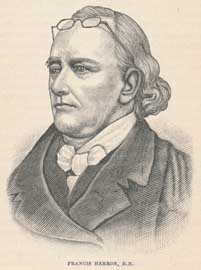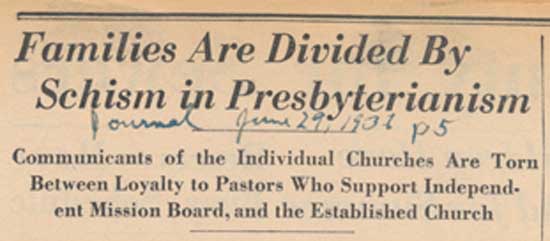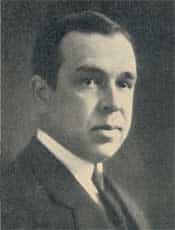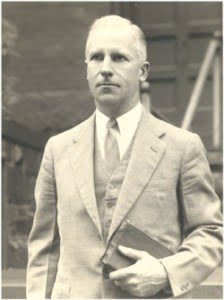20Faith Presbyterian Church
[left as First, lost property, changed name in 1974] Brookhaven MS Grace 1857 from PCUS, 6/10/1973; lost church property;
Org. 29 Aug. 1857 PCA Jack Ross, 1975-78; Shelton Sanford, 1980–84; Wayne Herring, 1985-89; Tommy Shields, 1989-95; Robert C. Oates, 1995-2009; Russell Hightower, 2010-14f.;
You are currently browsing the archive for the June 2020 category.
Standing Against Conformity to the World
FRANCIS HERRON:
Born, in Franklin County, Pennsylvania, June 28, 1774.
Graduated, at Dickinson College, Carlisle, Pennsylvania, May 5, 1794.
LIcensed to Preach, by the Presbytery of Carlisle, Pennsylvania, October 4, 1797.
Ordained to the ministry and Installed as Pastor of the Presbyterian Church at Rocky Spring, Franklin County, PA, April 9, 1809.
Removed to Pittsburgh, and Settled as Pastor of the First Presbyterian Church, May, 1811.
Resigned his Pastoral Charge, December 1850.
Died, December 6, 1860.
So in short compass the life of a venerable Presbyterian divine, as it is summarized at the head of a slim volume issued in his memory. Rev. Herron’s life, it was said, was “a life of more than usual historic importance.”
Francis Herron was born near Shippensburg, Cumberland county, Pennsylvania, on June 28, 1774. He belonged to that honored and honorable race, the Scotch-Irish, memorable in the history of the world, but especially in our country, for a thorough devotion to evangelical truth and constitutional liberty. The training of his early years bore rich fruit at a subsequent period of his life, making him so eminent among his brethren as an effective preacher and an orthodox divine.
Receiving the careful training indicative of his parents high regard for knowledge, he entered Dickinson College, Carlisle, PA, then under the care of that distinguished Presbyterian, Rev. Dr. Nesbitt. Here he completed his classical course, and graduated May 5, 1794. The prayers of his pious parents were answered by the influence of grace upon his heart, and he was led to study for the ministry of reconciliation. He studied Theology under Robert Cooper, D.D., his pastor, and was licensed by Carlisle Presbytery, October 4, 1797.
He entered upon his Lord’s service as a missionary, going out into the backwoods, as it was then called, passing through Pittsburgh, Pa., then a small village, and extending his tour as far west as Chillicothe, Ohio. Stopping for the night at a tavern at Six Mile Run, near Wilkinsburg, Pa., the people prevailed upon him to stay till the following Sabbath, which he did, and under the shade of an apple tree this young disciple broke the bread of life to the people.
His journey resumed the next day, and with a frontier settler for his guide, he pushed on to his destination through an almost unbroken wilderness, his course often guided by the “blazes” upon the trees. Two nights he encamped with the Indians, who were quite numerous near what is now the town of Marietta, Ohio.
On his return from Chillicothe, Ohio, he visited Pittsburgh. The keeper of the tavern where he lodged, proved to be an old acquaintance, and at his request, he consented to preach. Notice was sent, and in the evening a small congregation of about eighteen persons assembled. The house he preached in was a rude structure, built of logs, occupying the site of the present First Presbyterian church. And such was the primitive style of that day, that during the services the swallows, who had their nests in the eaves, flew among the congregation.
At this time the churches in that portion of our country were visited with a season of refreshing grace, and Mr. Herron entered into the revival with all the ardor of youth filled with hopefulness and zeal. He preached for Rev. Dr. John McMillan at the Chartiers church, during a revival season. He also preached at the Buffalo church, where his fervid eloquence made a deep impression and the people presented him a call, and strongly urged it upon his attention. He however concluded to return to the vicinity of his home, especially, as a call from Rocky Spring church was awaiting him. This call he accepted, and he was ordained and installed as pastor of that church, by Carlisle Presbytery, April 9, 1800.
Some ten years later, he was invited to occupy the pulpit of the First Presbyterian church, then vacant by the recent death of Rev. Robert Steele.
The people were charmed with his discourse, his ripening intellect modified by that refined spirituality, which was a prominent element in his ministrations, had a powerful effect upon his audience. They urged him to preach for them a second time, which he did, the result was a unanimous call was made out and presented to him in the usual manner.
The Presbytery of Carlisle dissolved the relation that existed between Rocky Spring church and Mr. Herron, and he was dismissed to Redstone Presbytery, April 3, 1811, and he was installed pastor of the First Presbyterian church, Pittsburgh, PA, the following June. In a few weeks he removed with his family to his new home, travelling in a large wagon, with his wife, children, and all his household goods.
He joined Redstone Presbytery June 18, 1811. The importance of his new position was fully and truly felt, the commercial importance of Pittsburgh had given all kinds of business an impetus, and prosperity was advancing rapidly; but this outward show referred only to worldly affairs, the religious condition of the people was cold and almost lifeless. The church to which he was called was embarrassed with debt, and the piety of the people manifested a degree of conformity to the world, which nearly appalled the preacher’s heart. But the experience of his ten years pastorate was to him invaluable, and girding himself, he entered upon his duties with a true heart and an earnest purpose. His preaching was the simple exposition of the truth as it is in Jesus, pointed, clear, and unwavering, revealing the enormity of sin and pleading with the fidelity of one who loved their souls. This style of preaching was sustained by his efforts to establish the prayer-meeting, which, strange as it now appears, met with much opposition, even among professors of religion; but this young pastor knew the holy influence of communion with God, and that God favored a praying people, he therefore went forward, and, in connexion with Rev. Thomas Hunt, who was pastor of the Second church, they persisted, and though to avoid a collision with the people the meetings were not held in the church, a small room was used for that purpose, in which Mr. Hunt taught a day-school. The first meeting consisted of the two pastors, one man, and six women, and thus for eighteen months did this meeting continue without adding a single person to their number.
The chilling indifference of the people soon grew into downright hostility, and husbands and fathers prohibited their wives and daughters from attending, and, finally, when the continued efforts of these pious people could be no longer borne, they waited upon Mr. Herron and told him that it must be stopped, his reply was the turning point in the spiritual condition of that people. He said, “Gentlemen, these meetings will not stop, you are at liberty to do as you please; but I also have the liberty to worship God according to the dictates of my conscience, none daring to molest or make me afraid.” From that time a spirit of piety manifested itself among the members of the church, several gay and fashionable persons were hopefully converted, and an impression was made upon the whole community, at once hopeful and healthful.
Words to Live By:
Do not expect courage of conviction from men who have no convictions, from those who have no anchor in the Word of God. The Scriptures must be drilled down deep into our souls if we are to stand against temptations and testings. May God give us pastors who will set an example, who will faithfully stand against the assaults of the world, the flesh and the devil.
Keeping in mind that newspapers were little different then than now, subject to the same human foibles*, nonetheless the following coverage of the modernist controversy and the resulting denominational split is interesting, as it offers some different perspectives on what a division means to those involved.
[*There are two errors that appear in the text below, both of which will be noted in brackets in their first appearance.]
This article is from a Wilmington, DE newspaper, dated June 29, 1936, and is found preserved in one of seven scrapbooks gathered by the Rev. Henry G. Welbon, covering the modernist controversy in the years 1935-1939. The photographs have been added and were not part of the original article.
Dissension with all the heartaches and strained loyalties that civil war brings, is definitely wedged in the Presbyterian Church in the U.S.A.
Where it will lead and the effect of the wedge, no one knows.
But this much is already evident in the Presbytery of New Castle, which embraced Delaware and parts of Maryland: families are divided, parents against children, husbands against wives, and friend with friend.
This is a time when members of congregations are torn between loyalty to their established church, when men are being accused of dogmatism, heresy, apostasy and free will.
Out of the seething cauldron has been born a new church, the Presbyterian Church in [sic; should be “of”] America, in contrast to the old Presbyterian Church in the U.S.A.
The nature of the wedge that is lodged in the church of the U.S.A. today is itself controversial.
Question Not Doctrinal
Those who are remaining loyal say the split is on a church constitutional question and among the loyalists are both fundamentalists and modernists.
“The matter now and never has been a controversy between ‘fundamentalists’ and ‘modernists’ the general council of the Presbyterian Church in the U.S.A. states.
It is a question the general council states, of whether ministers shall disobey the established constitution of a church and agree to the will of the majority.
The secessionists–all fundamentalists–say the differences are based upon doctrinal questions and liberty of conscience.
In any case, the immediate cause of the secession and the controversy has been the Independent Board of [sic; should be “for”] Presbyterian Foreign Missions, a board with no official connection with the Presbyterian Church in the U.S.A.
The leading personality in the Independent Board of Presbyterian Foreign Missions has been the Rev. Dr. J. Gresham Machen of the Presbytery of New Brunswick, N.J.
Four Judicatories in Church
For those not familiar with Presbyterian Church government, it should be explained that the judicatory and administrative bodies of the church are: First, the session, composed of representatives of a congregation, governing the church; second, the Presbytery governing a group of sessions in a district; third, the synod, a group of Presbyteries and fourth, the General Assembly which is the national ruling body of the Presbyterian Church which also is the supreme court and lawmaking body of the entire church.
Also as part of the story of the Independent Board of Presbyterian Foreign Missions is Pearl Buck, a missionary in China, whom it was charged was too much a modernist.
Dr. Machen Heads Movement
Though she resigned, the charges persisted from the militant fundamentalists of the Presbyterian Church against the alleged modernism in the foreign mission groups. In 1933, Dr. Machen introduced into the Presbytery of New Brunswick a proposed resolution to be presented to General Assembly relating to what he called “modernism” in the Presbyterian Board of Foreign Missions.
A large majority of the Presbytery of New Brunswick refused to send this resolution to General Assembly but similar resolutions did reach General Assembly in 1933. The assembly received it and Dr. Machen was heard by the committee to which the resolutions had been presented for consideration.
By a vote of 43 to 2, the committee reported unfavorably and expressed its confidence in the Board of Foreign Missions and by a nearly unanimous vote, the General Assembly approved the report of this committee.
But Dr. Machen did not pause there. Accepting neither the views of the committee nor the “judgment of the General Assembly,” he was influential in the establishment of the Independent Board of Presbyterian Foreign Missions, incorporated in December of 1933, with Dr. Machen as president. It is not a recognized body of the Presbyterian Church in the U.S.A., being just what its name indicates, “independent.”
H. S. Laird, Member of Board
To this board came the Rev. Harold S. Laird, pastor of the First and Central Presbyterian Church of Wilmington, an ardent fundamentalist.
But before he joined the independent board, he consulted with his session. He did not join against their counsel.
Another point, not widely known, is that Mr. Laird during his pastorate at First and Central Presbyterian Church never solicited for the Independent Board of Presbyterian Foreign Missions.
“It was only after much earnest prayer and careful consideration,” he said, “that I came to the conviction that this movement was of God, and being thus convinced, I agreed to throw what little influence I have in the church to the lifting high of this standard. This was my primary motive in allowing myself to be elected a member of the Independent Board for Presbyterian Foreign Missions.
“It is from this board that I was ordered to resign. I believe the board is of God and I also believe that my call to membership on that board was of God. Under such circumstances, how can I resign? Shall I obey man rather than God?”
Taking note of this independent board and that ministers and elders were prominent in its membership, the General Assembly directed that all ministers and laymen affiliated with the board sever their connections with the organization.
Those who declined to obey this direction were ordered tried by their Presbyteries. A number were found guilty and either rebuked or suspended.
Mr. Laird tried before the Presbytery of New Castle, protested that his affiliation with the independent board had been guided by his conscience and that in refusing to sever his connection, he was placing the word of God above the courts of man.
Rebuked, But Not Suspended.
Mr. Laird, however, was found guilty, with one dissenting vote in his favor. He was ordered rebuked but allowed to remain [in] his pulpit.
But Mr. Laird continued in the membership of the independent board. The Presbytery recently suspended him from the ministry–an act regarded as illegal by Mr. Laird who immediately renounced the authority of the Presbytery.
Words to Live By
Unity is a precious thing, to be cultivated and prized. But Christian unity must be centered on the saving Gospel of our Lord Jesus Christ. Where we have that unity, it is glorious. Without Jesus Christ as our Cornerstone, there can be no Church.
Luke 12:49-53 (ESV)
49 “I came to cast fire on the earth, and would that it were already kindled!
50 I have a baptism to be baptized with, and how great is my distress until it is accomplished!
51 Do you think that I have come to give peace on earth? No, I tell you, but rather division.
52 For from now on in one house there will be five divided, three against two and two against three.
53 They will be divided, father against son and son against father, mother against daughter and daughter against mother, mother-in-law against her daughter-in-law and daughter-in-law against mother-in-law.”
Psalm 133 (KJV)
1 Behold, how good and how pleasant it is for brethren to dwell together in unity!
2 It is like the precious ointment upon the head, that ran down upon the beard, even Aaron’s beard: that went down to the skirts of his garments;
3 As the dew of Hermon, and as the dew that descended upon the mountains of Zion: for there the Lord commanded the blessing, even life for evermore.
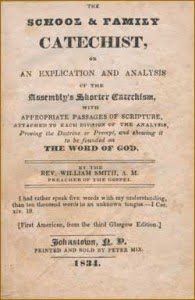
THE SCHOOL & FAMILY CATECHIST.
by Rev. William Smith (1834)
The Westminster Shorter Catechism,
Q. 105. What do we pray for in the fifth petition?
A. In the fifth petition, which is, “And forgive us our debts, as we forgive our debtors,” we pray, That God, for Christ’s sake, would freely pardon all our sins; which we are the rather encouraged to ask, because, by his grace, we are enabled from the heart to forgive others.
EXPLICATION.
Our debts. –Our sins are here called debts, because they show that God has not received from us what is due, and all the demands of his law and justice must be satisfied for them, before we can be again admitted into his favor.
Christ’s sake. –See Explic. Q. 98.
By his grace. –By God’s favor and help.
From the heart. –Freely, entirely, or without any remaining grudge in our minds.
ANALYSIS.
We here see, that when we use, in prayer, these words, “Forgive us our debts, as we forgive our debtors,” we pray for two things:
1. That God would freely pardon all our sins. –Psal. li. 1. Have mercy upon me, O God, according to thy loving-kindness; according unto the multitude of thy tender mercies, blot out my transgressions.
2. That God would do this for Christ’s sake. –John xvi. 23, 24. Whatsoever ye shall ask the Father, in my name, he will give it you. Ask, and ye shall receive, that your joy may be full.
In this answer we are likewise told, that we are encouraged thus to ask for the pardon of our sins from God, because, by his grace, we are enabled from the heart to forgive others. –Matt. vi. 14. If ye forgive men their trespasses, your heavenly Father will also forgive you.
A Plan of Action for Revival
If you look at some of the early Presbyterian Guardian issues on-line, you will notice on the masthead the name of the Constitutional Covenant Union. What was this organization?
The Covenant Union was an independent agency organized after the 1935 General Assembly of the Presbyterian Church, U.S.A. That national meeting brought some powerful indications that the conservative Presbyterians days were numbered in the visible church. So there went out a call to the supporters of the true Presbyterians to come to Philadelphia for a meeting on June 27, 1935. Over one hundred people answered the call. The Constitutional Covenant Union was organized, with officers elected, an executive committee named, and a constitution adopted. Chapters were to be organized, and a program of reform of the Presbyterian Church USA promoted.
That program was set introduced by an opening statement. The purposes were two-fold. It said, “we, the members of this Covenant Union are resolved, in accordance with God’s Word and in humble reliance upon His grace, to maintain the Constitution of the Presbyterian Church in the USA, (1) making every effort to bring about a reform of the existing church organization and to restore the church’s clear and glorious Christian testimony, which modernism and indifferentism have now so grievously silenced, but (2) if such efforts fail, and in particular, if the tyrannical policy of the present majority triumphs, holding ourselves ready to perpetuate the true Presbyterian Church, USA, regardless of cost.”
The meeting in Philadelphia would last from June 11 to June 14. It was upon its closing promptly attacked by not only the church machine of the denomination, but also from a surprising corner in the Rev. Samuel Craig, editor of Christianity Today. Remember, the latter magazine had been set up by Samuel Craig to expose the apostasy of the Presbyterian Church USA. But there were changes being made in his purposes around this time. Instead of supporting the Independent Board for Presbyterian Foreign Missions, he had resigned from both it, and the Board of Trustees of Westminster Seminary. Now Craig was advocating the support of sound missionaries of the official Board of Foreign Missions. When that became known, the Rev. McAllister Griffiths resigned as managing editor of Christianity Today, and became the editor of the Presbyterian Guardian.
Rallies began to be held in all parts of the country sponsored by this Covenant Union, with chapters formed in those areas. However, even with this remnant meeting, it was obvious that the second purpose of the Covenant Union would be realized. When the 1936 General Assembly met, and the supporters of the Independent Board for Presbyterian Foreign Missions were disciplined with expulsion, there was a call for another meeting. Taking place on June 11 – 14 in Philadelphia, the Covenant Union was dissolved and the Presbyterian Church of America came into being. (See June 11)
Words to Live By: J. Gresham Machen said on this occasion that we cannot trust the world. We cannot trust civilization. We cannot trust the visible church. When God speaks through His Word, we can trust only Him. His words are still true today. Make the blessed Book of books your guide this day.


